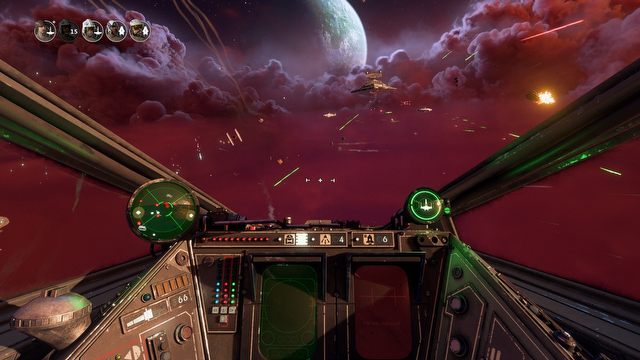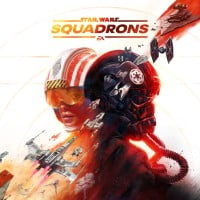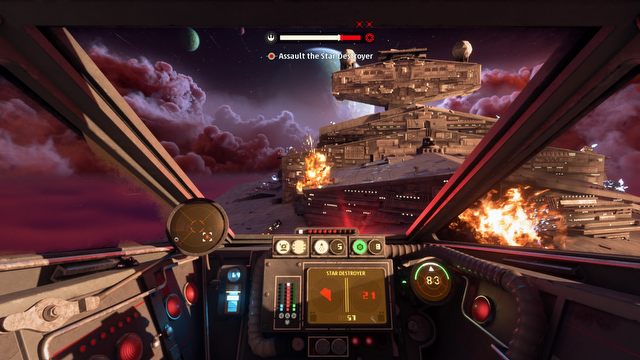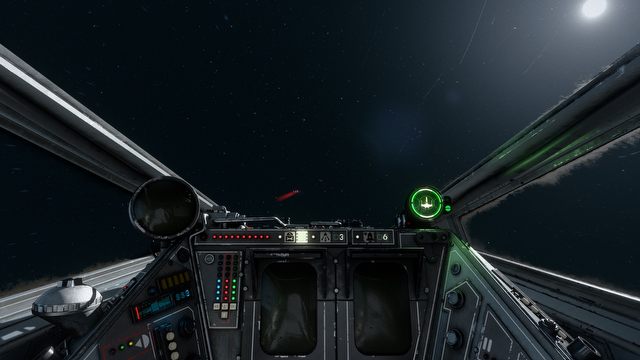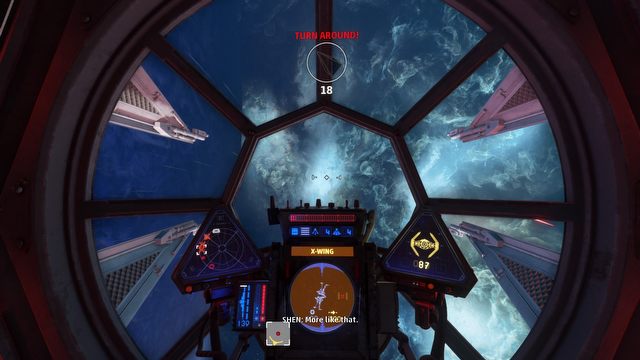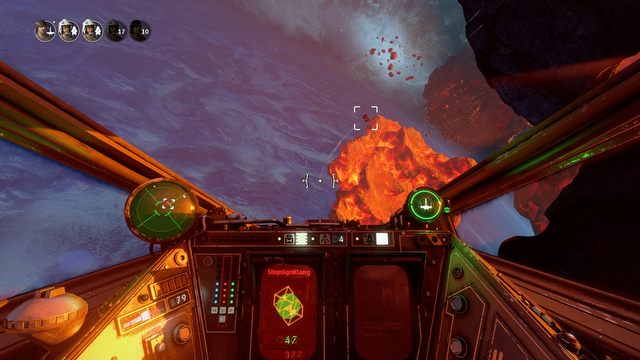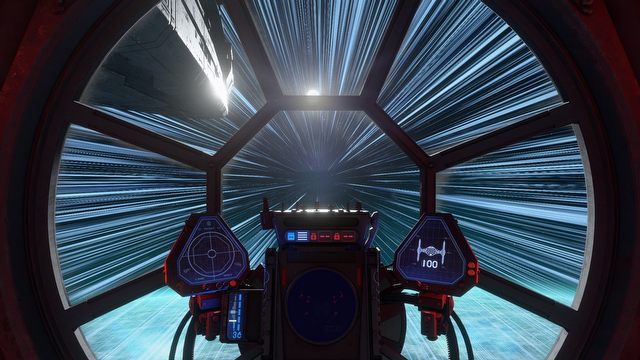Star Wars: Squadrons Review – Finally, X-Wing vs. TIE Fighter Returns!
Star Wars: Squadrons is a reminder that showing the universe of Star Wars from the perspective of a regular fighter pilot is a hit. It's just a pity that there's been a lack of momentum and truly epic action.
The review is based on the PC version. It's also relevant to PS4 version(s).
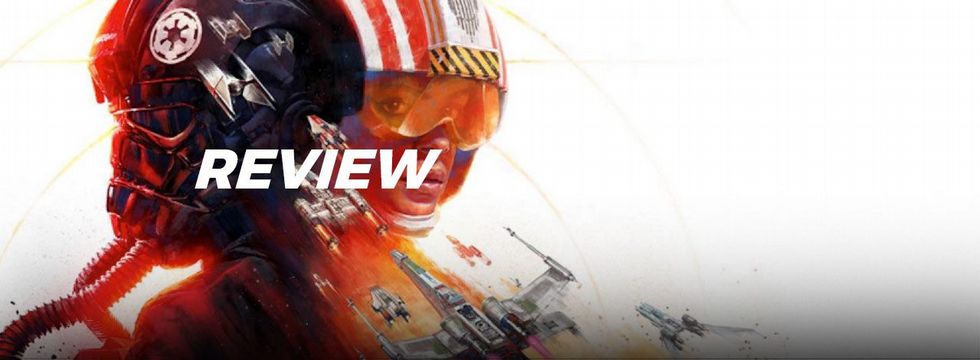
- superbly executed Starfighter dogfights…
- ...which makes an even bigger impression in a VR set;
- elements of flight simulation;
- strategic aspects in fleet battle mode;
- harks back to the X-Wing series.
- extremely weak plot;
- weak interactions with NPCs;
- single-player mission constraints;
- only two online modes;
- slightly claustrophobic, monotonous maps.
A long time ago, in the 90s...
The consoles war between Amiga and Atari was coming to an end. Owning a PC simply made a lot of sense, especially when games from the X-Wing series started coming out. It was the first time we could feel like the protagonist of a Star Wars movie, and the role-playing career of a star fighter pilot in the Wing Commander series was perfect for this universe. Subsequent installments started mushrooming; we got TIE Fighter, and the online X-Wing vs. TIE Fighter and the X-Wing Alliance that concluded the series.
Star Wars: The Force Awakens is just like X-Wing vs. TIE Fighter – a star fighter simulator with an emphasis on online fighting. Is this the best game Electronic Arts could have created in this setting? Surely not! But given the current popularity of simulators, or the attitude of modern players to games that require using more than six keys, it's not half bad, actually.
EA Motive's new game certainly brings back the vibes of the X-Wing series, and the space battles from inside the cockpit of small fighters, i.e. the mainstay of the gameplay, are extremely thrilling and satisfying. The sight of a TIE Fighter zooming in and out of your crosshair can be enchanting, especially when it finally explodes after an accyrate burst of laser weapons, not to mention a rallies over a smoldering Star Destroyer. But there are a few elements to these fights that don't work, and it's sometimes quite conspicuous that the game was developed on a tighter budget.
The force is weak with the plot
The original X-Wing vs. TIE Fighter didn't bring a solid storyline campaign at the time of release, for which the game was actually heavily criticized at the time. So the creators of Squadrons took no chances and our first moments with the game are a prologue to the single-player story mode. We alternately control a member of the New Republic Vanguard Squadron, and The Empire Titans, following the same story about the construction of the Rebels' new secret weapon, the powerful Starhawk spaceship. Unfortunately, writing here reaches Battlefront II lows. Boring, infantile, with bland characters and badly written dialogue.
The ideas for the main story and the side scenarios aren't quite bad. It's the execution that buries it. Most of the conversations and dialogues with NPCs take place between missions in a hangar and involve listening to monologues from motionless heads, as if we were playing an RPG from circa 2006. During the missions, in turn, we're mostly kept on a short leash. We can't just go about our business. The game forces us to closely follow short, tight stages, usually consisting of a few conversations, and few moments of travel concluded by a combat sequence. In fact, much of the campaign consists in passive listening and waiting for the game to finally let us to shoot something.
The developers were afraid to leave the player alone, afraid to let them decide and figure out how to proceed with the mission, instead firmly grabbing their hand and not letting go even for a second. It's a shame, because at the same time, a few solutions from the X-Wing series have been used, and in addition to combat, there are also tasks that have players scan objects, track and escort ships or weaken large units by destroying their systems. If only this could be done at our own pace, in big sandboxes and without constantly interrupting, the effect would be incomparably better.
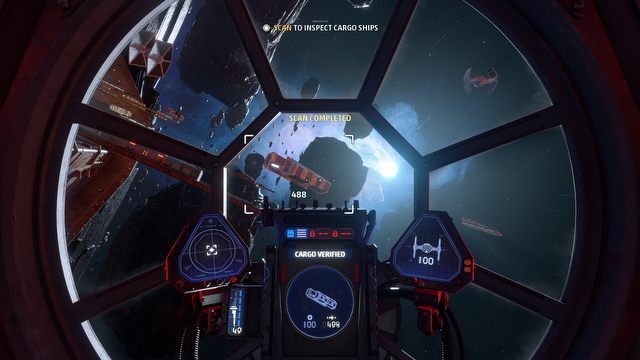
There were a lot of ideas from the first installments used in the missions, such as scanning of ships, but there could definitely be more freedom.
Combining the perspectives of both sides of the conflict in a single story also doesn't seem like the best idea. The story becomes diluted, and none of them receives appropriate attention in the end. I didn't root for anyone, I didn't like anyone, because basically all the events are contradictory. We strive to achieve a particular goal in one mission just to be ordered to burn it down completely in the next mission. Such narration did not convince me at all. Two shorter, but separate campaigns would serve the game much better.
Star Wars Simulator 2020
Fortunately, the story mode is merely an over-grown tutorial; an introduction to the real mainstay of the game – the online clashes of space fighter ships with elements of simulation In that respect, Star Wars: Squadrons really gives a ton of fun and satisfaction. We need to learn how to rapidly manage the ship's energy, the distribution of shields, the power of the engines, or the release of decoys to enemy missiles. Like in the first X-Wing, we can decide whether to protect the back or the front of the ship. We're able to decide what amount of power we can direct to guns to increase their firepower, or to give more juice to the engines to gain more maneuverability.
This multiplicity of options makes it quite difficult to maintain control if using a game pad, with accessing some options taking way too much time, as you have to call a wheel menu first. The control scheme is certainly well-conceived, but users of keyboards, or HOTAS joysticks will almost surely be at an advantage. Those controllers allow more ergonomic controls, with direct access instead of wheel menus.
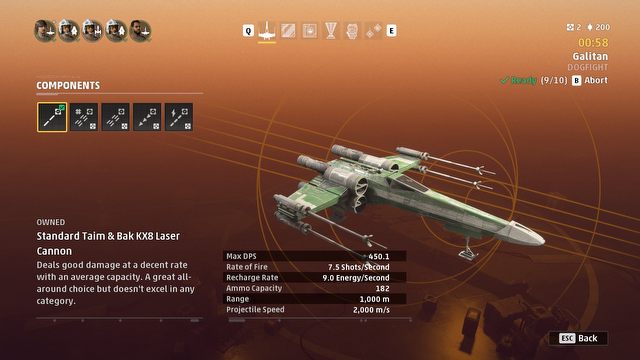
It's essential to chose the right kind of ship in different stages of fleet battles. You can also modify it's parameters.
There are also minor elements of strategy. During major battles, fleets may decide (without waiting for respawn) to switch agile fighter to heavy bombers, or supply ships to assist the allies with a new supply of guided missiles. Machines can replace guns, shields, or engines to get certain advantages at the expense of other features. This adds a bit of welcome tactical depth, although of course it's all still very dynamic, and a bit arcade. However, it's also far from the fighter battles in Battlefront II, which will be an advantage for some, and a fairly high entry threshold for others. A consolation is the ability to practice network modes with bots.
All (new) hope in multi battles
Of course, human enemies are much more challenging than the AI, so everything you can learn in the campaign and the practice grounds will come in handy. Star Wars: Squadrons unfortunately only offers two mulitplayer modes: team deathmatch and battle fleets, the main mode. In the former we don't find much finesse – just plain TDM, 5 vs. 5, whoever scores a set number of points, wins. The game feels best during battles, when the main objective becomes the destruction of the opponent's flagship: a Star Destroyer for the Empire, or the Republic's MC75 cruiser.
The game is based on the rules of virtual tug of war, although it also has something in common with MMO boss fights (in the statistics, you can see who inflicted the given amount of damage on the enemy ships). The main resource is morale, represented by a special bar. Filling it up allows you to move on to the next stage of the attack or, if you start losing, force you to retreat to increasingly deeper defense. In general, during each battle, we will repeatedly find ourselves in both situations, once pushing forward, then retreating in a disorganized manner.
This brings the mentioned tactical layer to multiplayer, because cooperation is important even at the ship selection stage. A team consisting entirely of light A-Wings or TIE Interceptors during the final push towards the flagship is a bad idea, so having the right sense of the situation and knowing the capabilities of all ships is key. There are only five players on each side (and SI units doing the "crowd"), and they try to take care of all that. Too bad the battles aren't bigger, with more ships to destroy and more players in each team.

The game uses AI-controlled "mobs," which, in a way, promotes cooperation within the 5-people teams.
Star Wars on budget
The sight of a Star Destroyer disintegrating after a long battle is something truly beautiful and gives plenty of satisfaction, but that's just part of the story. The "victory screen," for example, is a repetitive cut-scene, rather than animation based on gameplay. The team can't fly along the exploding ship and enjoy the view – before that could happen, everyone's kick out of the map. Is Frostbite running our of breath?
I also got the impression that the attacks on flagships are somewhat simplified and that the morale bar is more important than the actual destruction of the critical systems, which would probably be a more interesting solution. The AI units make it somewhat difficult to sense when the ship will be destroyed and who fired the decisive shot.
The biggest problem of Squadrons is the amount of content. All the fights are carried out according to the same pattern, without the slightest dose of randomness, save for rotating maps (six of them in total, all quite similar), so this doesn't bode well for the game's lifespan. The creators have no plans for new content thus far, and the only motivation seems to be offered by a handful of cosmetic items and a ranking system. The upside, however, is that everything in the game is acquired through gameplay – there are no micropayments!
I'm still waiting to see a map that would just show dark, empty void of space. All the locations are as colourful as a garden in late spring, and there's always some background with clouds or some other nebulae. It's a bit like in the FPS from the 90s, in which levels with 3D corridors were filled with static images. This, combined with quite conservative constraints of space (if you fly to far away from the center of action, your ship automatically turns around), makes for a rather claustrophobic vibe of the entire game. The black void of the cosmos would add some depth and space. I also miss a map set directly above the surface of a planet.
VR-Wing vs. VR Fighter
Many of the drawbacks become insignificant once we start playing in VR. The freedom to look around and the sense of immersion make it all about the opponent in the crosshair; the fight right here and right now, rather than the number of available modes. In this respect, Star Wars: Squadrons seems a big step forward compared to the previous X-Wing Mission VR demo for PS4. It shows that VR is simply made for simulators.
Such equipment, however, is still the exception rather than the norm for players, as are HOTAS kits, and this makes Squadrons potentially a very different kind of experience. It will be a fairly difficult game with little content and a weak plot for many players. For others, it's going to be an opportunity to put their hardware to use, or remember what Star Wars games felt like back in the day. It may not make the same impression as these old titles used to, but it's good that the gaming world has finally brought back the space dogfights of X-Wings and TIE Fighters. Perhaps the next installment will show us interstellar battles on a grand, epic scale?
ABOUT THE AUTHOR:
I spent several hours with Star Wars: Squadrons – first on the PS4, testing the game on dualshock, and then on the PC with a HOTAS set. It took me about seven hours to get through the campaign consisting of 14 missions, much of the time spent passively listening and waiting. The game awards medals for completing each mission below a certain time limit – usually 15-17 minutes.
I've had much better time in multi, which actually hasn't bored me yet, but I'm not sure whether that will last. I used to play all these games, starting from the first X-Wing to Alliance and the arcade rail shooter Rebel Assault. Squadrons is by far the least "epic" of all these games.
Star Wars: Squadrons
Star Wars: Squadrons Review – Finally, X-Wing vs. TIE Fighter Returns!
Star Wars: Squadrons is a reminder that showing the universe of Star Wars from the perspective of a regular fighter pilot is a hit. It's just a pity that there's been a lack of momentum and truly epic action.



